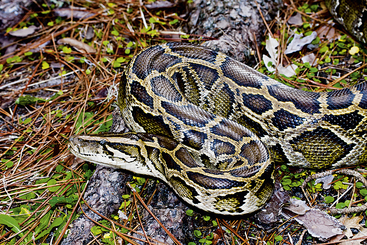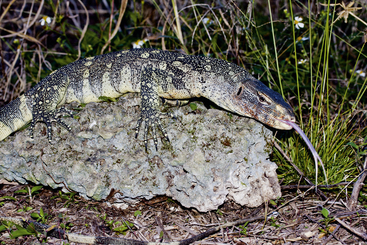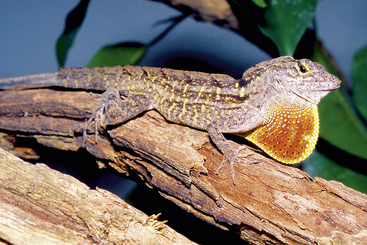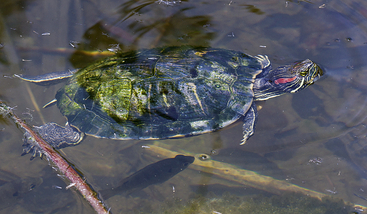Chapter 28
Invasive and Introduced Reptiles and Amphibians
Amphibians and Reptiles
Why is there a section on introduced amphibians and reptiles in this volume, and why should veterinarians care about this issue? Globally, invasive species are a major threat to the stability of native ecosystems,1,2 and amphibians and reptiles are attracting increased attention as potential invaders. Some introduced amphibians and reptiles have had a major impact (e.g., Brown Tree Snakes [Boiga irregularis] wiping out the native birds of Guam3 or Cane Toads [Rhinella marina] poisoning native Australian predators).4 For the vast majority of species, however, the ecological, economic, and sociopolitical effects of introduced amphibians and reptiles are generally poorly quantified, largely because of a lack of focused research effort rather than because such effects are nonexistent. This trend is alarming given that rates of introduction have increased exponentially in recent decades.5,6
The state of Florida has experienced more documented introductions of exotic herps (139 species are known through 2010) and has more established species (57) than anywhere else in the world.6–8 However, the problem is certainly not limited to Florida: Hawaii has 31 established species of nonnative herps, California has 19 established species, and the magnitude of the problem in the United States (whether measured in the number of species or the geography of introductions) is likely to increase.5 Many of these numbers are certainly underestimates of the actual number of established species because many introductions are of small and/or secretive species that have yet to be discovered or reported to researchers and a number of challenges are associated with determining when released individuals become a reproducing population. Although most established populations are in the warmest climates of the United States, some species have established in more temperate areas (e.g., European Wall Lizards [Podarcis spp.] have established in several northern cities). Furthermore, as international standards of living rise and the demand increases for pets, additional populations of introduced herps can be expected to become established around the globe. As an example, introduced populations of California Kingsnakes (Lampropeltis californiae) originating from the pet trade are now widespread on Grand Canary Island and threaten populations of endemic vertebrates9; this example is more remarkable for the fact that these snakes are albinos, a recessive phenotypic trait usually thought to be associated with low survival rates because light-colored individuals are detected by predators at much higher rates than are their normally colored conspecifics.
High-Profile Introductions in the United States
Giant Constrictor Snakes
Of all the introduced herps in the continental United States, Burmese Pythons (Python molurus bivittatus or P. bivittatus) in Florida have attracted the most attention from the media and general public (Figure. 28-1). A large population of pythons (estimates from credible sources start at 10,000 pythons and increase from there) is spread across several thousand square kilometers of the Everglades and adjacent ecosystems,10,11 and these exotic snakes consume a variety of vertebrates such as mammals (including domestic pets), reptiles, and birds, many of which are species of conservation concern. Effects on native species may be severe.12 Two additional established species of giant constrictors (Boa Constrictor [Boa constrictor] and Northern African Python [Python sebae]) are as yet confined to smaller areas.13,14 The Boa Constrictor is also an established invader on several Caribbean islands.11 All three exotic snake species were introduced via the pet trade, but only the Burmese Python has been studied enough to be labeled as invasive.
Large Lizards
There are currently at least five species of established large lizards in Florida: Green Iguana (Iguana iguana, Figure 28-2), Black Spiny-tailed Iguana (Ctenosaura similis, Figure 28-3), Mexican Black Spiny-tailed Iguana (Ctenosaura pectinata), Nile Monitor (Varanus niloticus, Figure 28-4), and Argentine Tegu (Tupinambis merianae). All were introduced via the pet trade, and all but the Mexican Black Spiny-tailed Iguana have been studied enough to be labeled as invasive. Iguanas are known to carry and possibly transmit Salmonella to humans,15 the Black Spiny-tailed Iguana has been documented consuming the protected Gopher Tortoise (Gopherus polyphemus),16 as well as birds and their eggs,17 and the Nile Monitor is known to consume birds, bird eggs, and crocodile eggs but is large enough to also take domestic pets. The Tegu and Monitor Lizard inhabit relatively temperate climates in their native ranges, which suggests that they may be an establishment risk for other states.
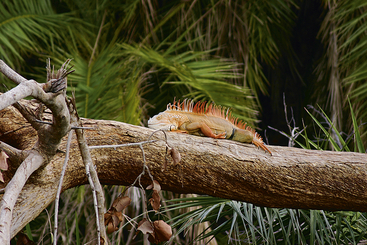
FIGURE 28-2 Despite the color implied by their common name, Green Iguanas (Iguana iguana) may exhibit a variety of colors. This is especially true of males such as this bright orange individual.
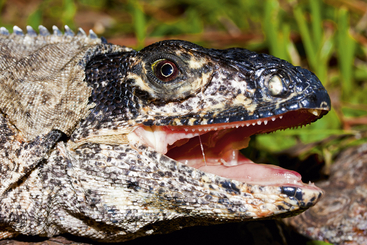
FIGURE 28-3 The Black Spiny-tailed Iguana (Ctenosaura similis) is the largest member of its genus, and males can approach 1.5 m in total length.
Anoles
There are roughly 60 populations of about 20 species of established introduced anoles worldwide, including at least nine species established in the United States and its insular territories (Figure 28-5).5,6 While ecological effects have been documented for some species, such as Brown Anoles (Anolis sagrei, Figure 28-6) in Florida,18 most introductions have received little to no ecological attention. In Florida, residents often spray insecticides to control insect pests around their homes—these insecticide applications have been observed to occasionally result in the death of domestic cats that have consumed introduced Brown Anoles that in turn had ingested toxic and dying insects (Krysko KL: Pers. com., 1988).
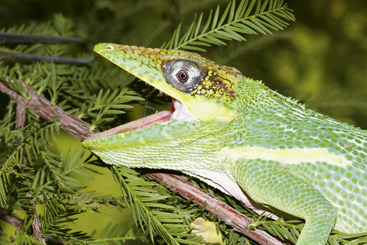
FIGURE 28-5 Among the largest of the species-rich anole clade, the Knight Anole (Anolis equestris) is a diurnal predator on invertebrates and small vertebrates. Long-established populations in Florida appear to be sensitive to cold weather, thus restricting their spread northward.
Turtles and Tortoises
The Red-eared Slider (Trachemys scripta elegans, Figure 28-7) is established outside of its native range in multiple countries and in the United States, and several other species are established in the United States. Pet sliders are often released into urban and suburban bodies of water; thus this species may be one of the introduced herps most commonly encountered by veterinarians across the country. Turtles are typically introduced via the pet trade and human food pathways. Aquatic turtles are known to carry and possibly transmit Salmonella to humans, and Leopard Tortoises (Stigmochelys pardalis) in the pet trade have been found infested with African ticks (Amblyomma spp.) that carry heartwater disease, which is potentially fatal to ungulates.19
Stay updated, free articles. Join our Telegram channel

Full access? Get Clinical Tree


